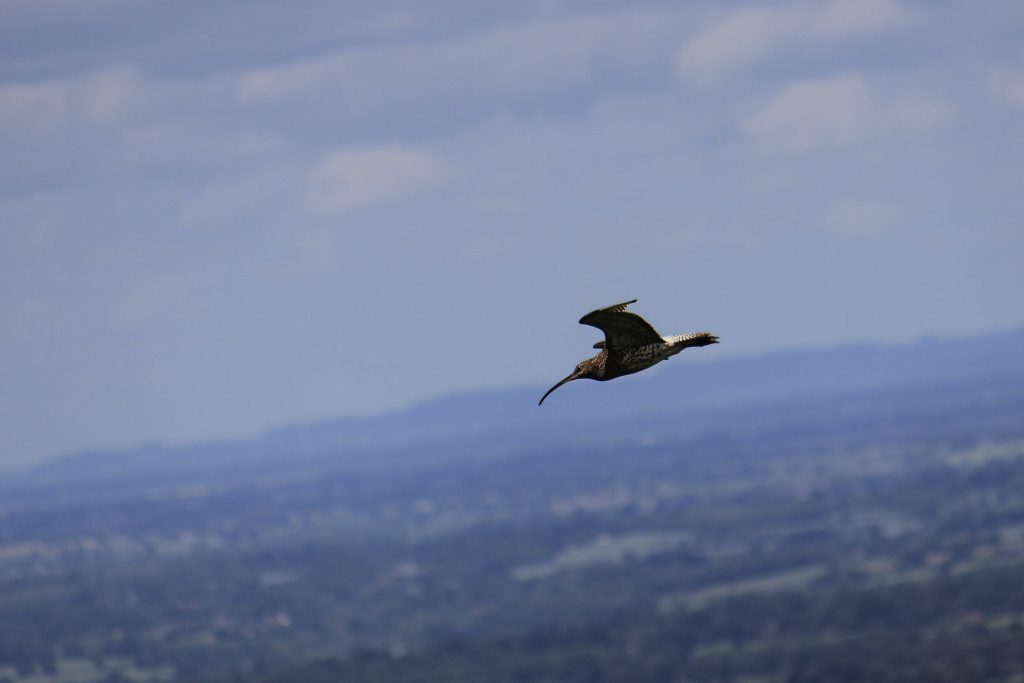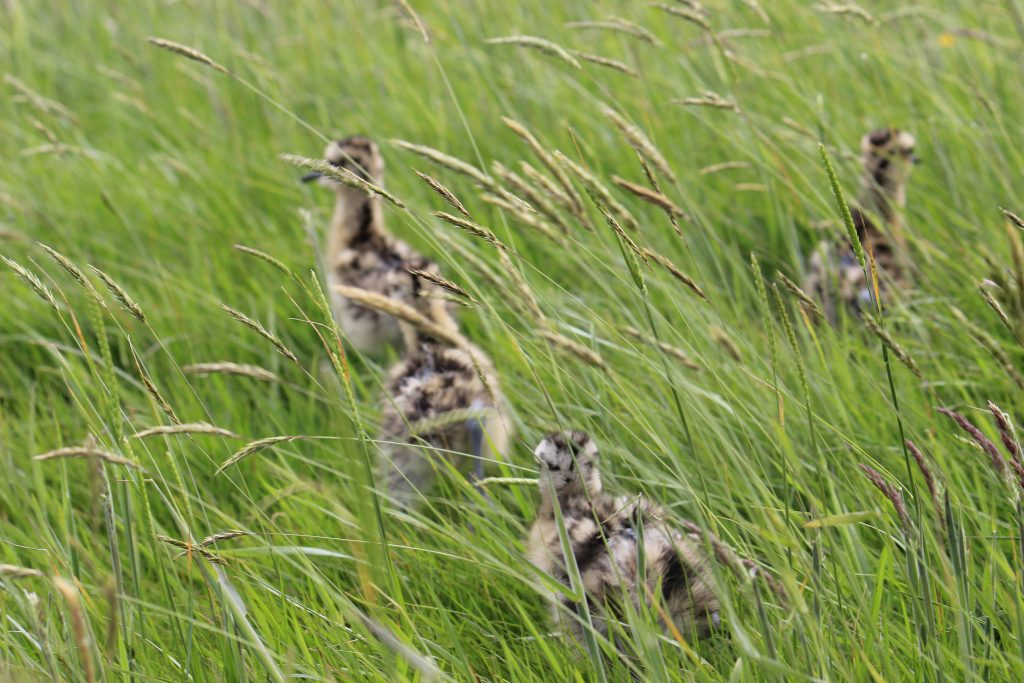Amber Bicheno, Stiperstones and Corndon LPS Trainee, has been assisting with the Curlew Country Project in 2017. Find out what she’s been doing with the team this week (07/06/2017).
This was the next step. It meant we had made it, at least a little further, in successfully getting some nests to hatching stage. This in itself feels like quite a feat after the depressing outcomes of previous years, just getting more eggs to hatch! But now comes the radio tracking, with a whole new set of trials and tribulations.
The day started off with some good news, Tony and Tim burst into the office for a much needed cup of tea after ![]() successfully re-finding all three chicks from a nest in Wales. After the last few days of heavy rain and unrelenting wind, it felt like a small victory knowing the whole of this clutch, at least, was still alive.
successfully re-finding all three chicks from a nest in Wales. After the last few days of heavy rain and unrelenting wind, it felt like a small victory knowing the whole of this clutch, at least, was still alive.
So far in the season I have managed to gain quite a bit of experience in nest finding. A long and arduous process that seems to rely more on luck than anything else, especially if you are not an ultra-experienced ornithologist (Yes, I mean you Tony). The knowledge that it can sometimes just be down to “the way the bird tilts its head, or the look in its eye” was not of great comfort. Nevertheless, I still went out and looked, watched, wandered and walked in search of nesting curlew, and hopefully went some way to helping find at least a few.
This new stage in the curlew saving cycle seemed welcome and exciting, and seeing adorable fluffy curlew chicks was always going to win me over. So off we went to locate four chicks at another site. These four were some of the earliest to hatch, and having been seen alive and well on Saturday morning Tony hoped to find at least one of them alive today.
After setting off in Tony and Tim’s 4x4s (my little car wouldn’t survive some of the bumpy roads we needed to visit!), we pulled into the farm where the chicks had last been seen. The radio receiver is a small but essential bit of kit, and when the tags are attached to the down of the chicks each has a unique number which is noted. These numbers relate to different frequencies, which the receiver will scan and a ‘beep’ will emit if the tagged chick is nearby.
The receiver is attached to an aerial, which Tony will wave around in the field to cover all directions. The range of this set up is quite variable, and depends a lot on the terrain that is being searched. If it is fairly flat and the tag is within line of site it should reach to at least 300m, but if the fields are not flat (like most of Shropshire and Wales) then this gets somewhat diminished.
 Tim and I watched and waited, as Tony wandered the fields waving the receiver. First the field where the nest had been, and lo, an adult curlew flew up into the air making its unmistakable bubbling call and landing in the next field. So that field next, and again up the bird flew, this time with its partner! But oh,
Tim and I watched and waited, as Tony wandered the fields waving the receiver. First the field where the nest had been, and lo, an adult curlew flew up into the air making its unmistakable bubbling call and landing in the next field. So that field next, and again up the bird flew, this time with its partner! But oh,
“That’s not good” we hear Tony say, “they’ve both flown off, if they’ve got chicks they should be staying close by and making a fuss”.
They were also making the wrong call it turned out, not the “get away from my chicks” shout but their more general “get away from my territory” call. Tony continued scanning the nearby fields, but to no avail. It looks like these chicks hadn’t made it.
With heavy hearts and a feeling of disbelief that 4 chicks could have disappeared so quickly, we decided to try another brood with fingers crossed for more happy news. This was another nest of four chicks, and one that I had witnessed the tagging of personally. The field is vast, with lovely tall lush grass interspersed with buttercups and sorrel, seemingly ideal for providing food and shelter to the growing curlew chicks. We head out again with the receiver, aerial ready and waving, down the middle of the field towards the last place the chicks had been seen. No beeping yet, so we crossed through a gate into the adjacent field, home to some young bullocks and the occasional calling quail.
Following the fence line down a single beep rang in our ears,
“Is that the right noise?” I enquired,
“Yes, but I think the damned things broken, must be a dodgy connection.”
A mix of good and bad news. We continued in the direction of the single beep, and up rose a curlew, sounding very annoyed indeed. This was the right call, definitely a sign that at least one of the chicks was still alive. I felt a moment of joy, followed quickly by fear as the young bullocks’ spotted earlier started racing across the field towards the spot the angry curlew parent had just vacated. We watched with bated breath, as curlew circled overhead before landing in the field next door, back to the safety of the long lush grass. Interestingly another curlew got up briefly from the same field, we approached the fence and then…
“Can you hear that Tony?”
“Hear what?”
“Is that the chicks chirping?”
“…It is!”
Joyfully Tony leapt over the fence and started off, very carefully checking every step, in the direction of the cheeping noises. Curlew being one of the most threatened birds in the UK, Tim and I remained behind, as we were reluctant to put this future generation unnecessarily at risk with any misplaced steps. So I watched and listened, Tim attempted to fix the dodgy connection (he found a temporary solution that would work for short range), until Tony finally signalled to us that he had found one.
noises. Curlew being one of the most threatened birds in the UK, Tim and I remained behind, as we were reluctant to put this future generation unnecessarily at risk with any misplaced steps. So I watched and listened, Tim attempted to fix the dodgy connection (he found a temporary solution that would work for short range), until Tony finally signalled to us that he had found one.
He made his way back to us, and showed us a fluffy, gangly looking creature, letting out an occasional squeak, far more wriggly and uncooperative than the last time I had met them! Seeing Tim’s quick fix on the receiver he handed me the first chick found and head back out to try and track down the others. I sat down in the long grass admiring the little wriggly ball, mostly made up of legs and feet, trying to contain it until Tony returned.
Another shout from Tony, Tim picked his way through, returning shortly with something moving inside his fleece. Another chick! The news just got better, as not long after Tony returned with another, making three.
“I’m just going to try and find the last one, see if you can weigh those ones whilst I’m gone.”
 Tim and I exchanged looks of apprehension, with three curlew chicks taking up most of our efforts to control. The weighing of the curlew chicks involves placing them inside a paper cup on a set of small digital scales. It should be simple.
Tim and I exchanged looks of apprehension, with three curlew chicks taking up most of our efforts to control. The weighing of the curlew chicks involves placing them inside a paper cup on a set of small digital scales. It should be simple.
I went first, since I was only holding one chick, Tim stashed the other two inside his fleece again to keep them out of mischief and allowing him a free hand to write notes. First we had to read the number of the ring on the chicks’ leg, and I can assure you that begging them to keep still has no effect. Once this has been noted you must next get the bird into the cup, no easy feat, although through sheer luck something I achieved on the second or third attempt. Tim recorded the weight and we moved onto the next, getting a bit more of a rhythm going for the other two, though doubtless Tony could manage the process in half the time.
Tony returned with the fourth and final chick, much to our amazement. All were of a good weight, and seemed to be keeping warm in spite of the changeable weather. The chicks were released back into the long grass, running and disappearing surprisingly fast, and although happy at our success, finding them again in the future felt all the more daunting and important. It is these chicks, and others like them, which we need to survive, to secure a future for Curlew both here and across the UK.
So concluded my first adventure into radio tracking. Clearly an activity filled with ups and downs, but one that will take up more time when the remainder of our nests hatch. We hope that by finding the chicks again and following their movements, we can gain much needed information on what they need to survive. Information that could prove vital if we are to have any hope of halting their decline.
